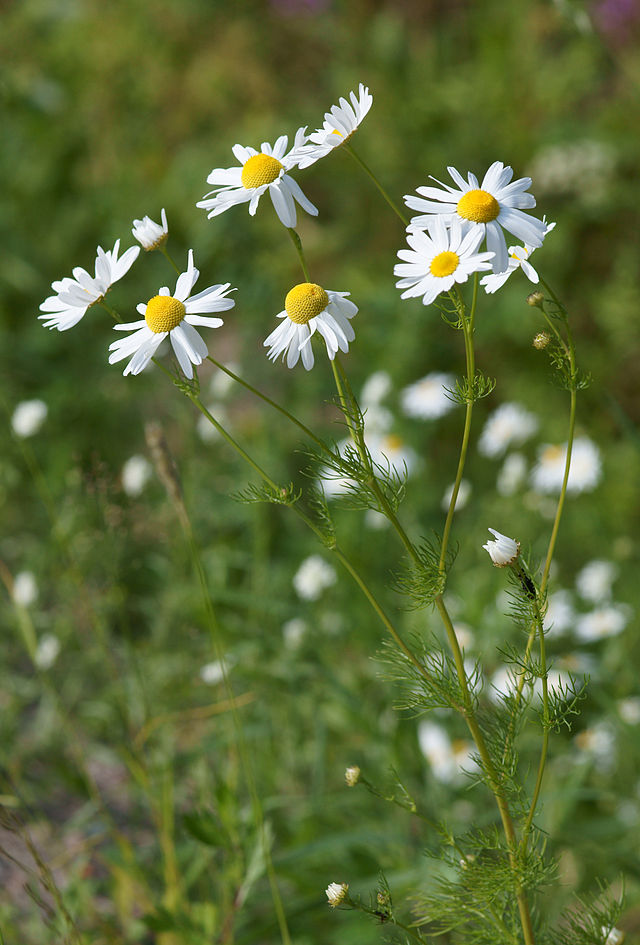Loading AI tools
Common name for several daisy-like plants From Wikipedia, the free encyclopedia
Chamomile (American English) or camomile (British English; see spelling differences) (/ˈkæməmaɪl, -miːl/ KAM-ə-myle or KAM-ə-meel[1][2]) is the common name for several daisy-like plants of the family Asteraceae. Two of the species, Matricaria chamomilla and Chamaemelum nobile, are commonly used to make herbal infusions for beverages.[3][4][5] There has been limited (though thus far insufficient) research as to whether consuming chamomile in foods or beverages is effective in treating medical conditions.[4][5]


The word chamomile is derived via French and Latin, from the Greek χαμαίμηλον, khamaimēlon, 'earth apple', from χαμαί, khamai, 'on the ground', and μῆλον, mēlon, 'apple'.[6][7] First used in the 13th century, the spelling chamomile corresponds to the Latin chamomilla and the Greek chamaimelon.[7] The spelling camomile is a British derivation from the French.[7]

Some commonly used species include:
A number of other species' common names include the word chamomile. This does not necessarily mean they are used in the same manner as the species used in the herbal tea known as "chamomile". Plants including the common name chamomile, of the family Asteraceae, are:


Chamomile may be used as a flavoring agent in foods and beverages, mouthwash, soaps, or cosmetics.[5]
Chamomile, chiefly Chamaemelum nobile cultivars, is used to "upholster" chamomile seats, raised beds which are about half a meter tall, and designed to be sat upon.[10] Chamomile lawns are also used in sunny areas with light traffic.[11]
Chamomile tea is a herbal infusion made from dried flowers and hot water, and may improve sleep quality.[3] Two types of chamomile are used, namely German chamomile (Matricaria recutita) and Roman chamomile (Chamaemelum nobile).[3]
Chamomile has historically been used in making beer and ale.[12] Unlike for tea, in which only the flowers are used, the whole plant has been used to make beers and ales, adding a bitter flavor component favored by craft breweries and homebrewers.[13][14]
The main compounds of interest in chamomile flowers are coumarins, flavonoids, and polyphenols,[8] including apigenin, quercetin, patuletin, luteolin, and daphnin.[15][16] It is currently unclear whether chamomile is effective in treating any medical conditions.[5] Chamomile is under preliminary research for its potential anti-anxiety properties.[8] There is no high-quality clinical evidence that it is useful for treating insomnia.[17]
The use of chamomile has the potential to cause adverse interactions with numerous herbal products and prescription drugs and may worsen pollen allergies.[5] People who are allergic to ragweed (also in the daisy family) may be allergic to chamomile due to cross-reactivity.[3]
Chamomile consists of several ingredients including coumarin, glycoside, herniarin, flavonoid, farnesol, nerolidol and germacranolide. Despite the presence of coumarin, as chamomile's effect on the coagulation system has not yet been studied, it is unknown whether a clinically significant drug–herb interaction exists with anticoagulant drugs.[5] However, until more information is available, it is not recommended to use these substances concurrently.[18]
Chamomile should not be used by people with past or present cancers of the breast, ovary, or uterus; endometriosis; or uterine fibroids.[5]
Because chamomile has been known to cause uterine contractions that can invoke miscarriage, pregnant women are advised to not consume Roman chamomile (Chamaemelum nobile).[4] Although oral consumption of chamomile is generally recognized as safe in the United States, there is insufficient clinical evidence about its potential for affecting nursing infants.[5]
The chamomile plant is known to be susceptible to many fungi, insects, and viruses. The following fungi are known to attack this plant: Albugo tragopogonis (white rust), Cylindrosporium matricariae, Erysiphe cichoracearum (powdery mildew), E. polyphage, Halicobasidium purpureum, Peronospora leptosperma, Peronospora radii, Phytophthora cactorum, Puccinia anthemedis, Puccinia matricaiae, Septoria chamomillae, and Sphaerotheca macularis (powdery mildew). Also, yellow virus (Chlorogenus callistephi var. californicus Holmes, Callistephus virus 1A) causes severe damage to this plant. [19]Aphids (Aphis fabae) have been observed feeding on chamomile plants and the moth Autographa chryson causes defoliation.The insect Nysius minor caused shedding of M. chamomilla flowers,[19]
The 11th century part of Old English Illustrated Herbal has an illustrated entry.[20] Nicholas Culpeper's 17th century The Complete Herbal has an illustration and several entries on chamomel.[21][22]
Seamless Wikipedia browsing. On steroids.
Every time you click a link to Wikipedia, Wiktionary or Wikiquote in your browser's search results, it will show the modern Wikiwand interface.
Wikiwand extension is a five stars, simple, with minimum permission required to keep your browsing private, safe and transparent.